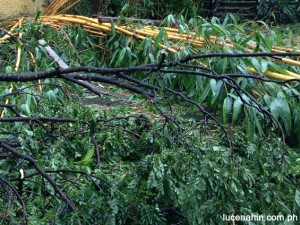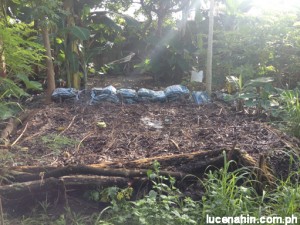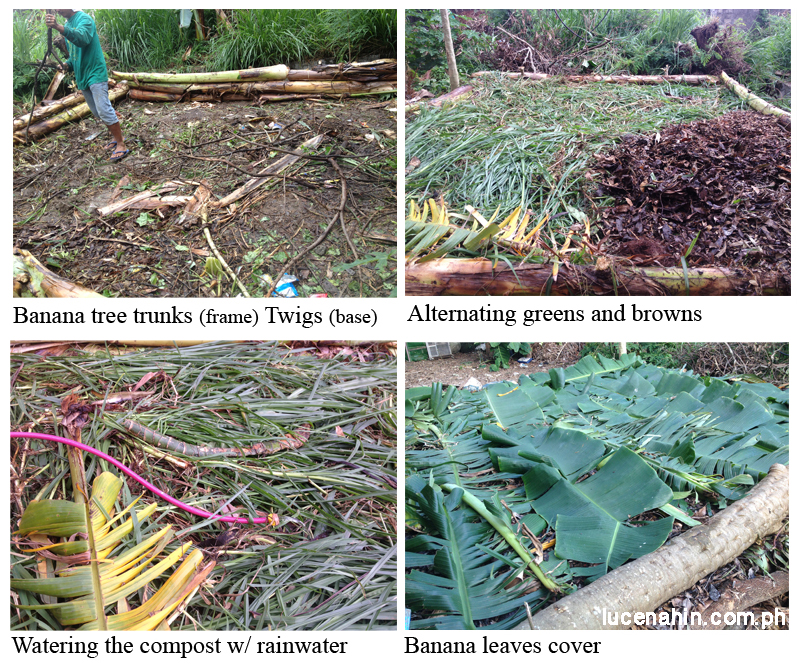Basic Composting III: Simplified Heap Composting
 There are times when we have lots of brown and green materials that we need to dispose of. While typhoon Glenda brought massive destruction in Lucena and along her path, she also left us with a lot of compostable materials that we can use for Heap Composting.
There are times when we have lots of brown and green materials that we need to dispose of. While typhoon Glenda brought massive destruction in Lucena and along her path, she also left us with a lot of compostable materials that we can use for Heap Composting.
What else can we do with the cards we’ve been dealt, right? Although of course, if you have another source of green and brown materials (detailed below) then good for you.
What you’ll need
- Space for your heap. Preferably partially shaded and need to be able to fit at least a 3 cubic feet heap (length: 3 ft, width: 3 ft, height: 3 ft). This will ensure that your compost will heat up.
- Brown Materials. Any compostable materials that are dry and are brown in color. In our case, dried leaves and branches. We also started our heap about 5 weeks after Glenda, so we had plenty of browns.
- Green Materials. Grass clippings, plant cuttings, vegetable scraps, chicken manure or dried pet bird manure. We didn’t add vegetable scraps because we set the pile up in the unused space at the back of our office and we didn’t want to attract pests. Since we will also be growing our garden there, we cleared up the area and used mostly grass clippings for our greens.
- Materials as wall frame. We used banana trunks and big tree branches that were destroyed by the typhoon.
- Gardening Tools such as hedge clippers, large pruners, knives and shovel.
- Water
What to do
- Create a frame for your heap so things won’t fall out.
- First things to add are tree branches and twigs. They should be at the base of your heap for air circulation.
- Add few browns to fill the gaps.
- Add your greens then browns alternately.
- The mixture of greens and browns is approximately 30% green and 70% brown, although some resources says equal parts and some with their own ratio. We followed the 30/70 but I think there’s no need to be that accurate as long as the greens are less or equal to the browns and as long as your heap doesn’t smell bad.
- Water each layer to dampen it a little if needed, before adding another layer. We used water from our rainwater harvesting drums.
- You can also add garden soil or your finished compost to speed up the process. We had extra EM1 solution (the one you also used in Bokashi Composting) which we used but I can’t say for sure if it helped because I didn’t test.
- Then you can cover the pile with banana leaves to finish like we did and you’re DONE!
To check if your compost is heating up, you can stick in your arm, or hand in my case, in the compost heap after a few days, and you can feel the hot temperature inside. We didn’t check the actual temperature.
- Do not add anything to your heap pile.
- You can turn the pile after a couple of months for faster decomposition. We didn’t do this though.
 After a few months, you will notice that the heap size has gotten smaller, almost half of its original size. You can see partially decomposed branches too.
After a few months, you will notice that the heap size has gotten smaller, almost half of its original size. You can see partially decomposed branches too.
Remember, you should NOT be adding anything else to the pile. You can either start another pile, do leaf mold composting or other practices for the garden waste you accumulate.
- Then you can sift the finished product to get fine compost.
- Lastly, you can keep some to add to the next batch to activate it.
We were able to get compost in almost 5 months, which is longer than if you would turn the pile. And there are many ways to accelerate composting like this one where you can harvest in as little as 18 days. I think we were able to harvest early because it was rainy that time too. Today, our new pile is already dry because of summer and we decided to just wait and see what will happen with this batch.
On a side note, while researching for this post I learned a little tidbit about typhoons. Did you know that the many Cocolisaps that troubled Quezon’s coconut industry then were blown away by Glenda? Same with the pests in our garden as well. Apparently, typhoons also bring in about 1/4 to 1/2 of our total fresh water supply for the year while helping regulate the temperature in the tropics too. The more I learn about nature, the more I am amazed and the more I feel permaculture gardening is the right choice for me.
This is part 3 of the Basic Composting Series. You can read about composting tree leaves and your kitchen waste in the first 2 parts of the series.
References:
http://science.blurtit.com/2561469/how-typhoons-effect-the-environment
http://greenanswers.com/question/are-there-any-positive-effects-typhoons/
http://en.wikipedia.org/wiki/Effects_of_tropical_cyclones


 Philippine Peso
Philippine Peso